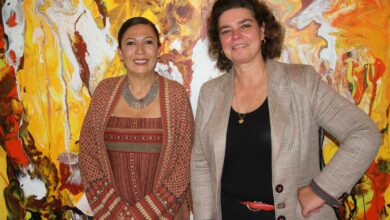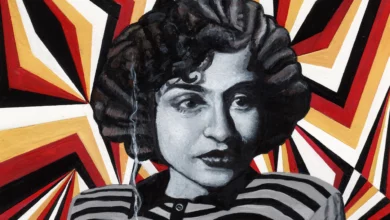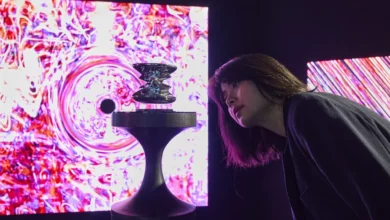For the entire month of February 2010, an air conditioning unit was fixed to the Palace of the Arts’ façade, right above the word Kasr (Palace). A common sight on buildings throughout the city, this particular unit was a site-specific installation piece by Egyptian artist Ahmed Foula called "Air Condition," part of the Opera House’s Why Not? exhibition.
"Air Condition" successfully commented on the ability of a single object to engage people with a variety of interests depending on their individual interpretation of the placement of the object–banal, but nevertheless an imposition on Cairo's public space. Proponents of socially engaged art read the piece as a commentary on global warming. Others considered "Air Condition" to be a conceptual piece, a humorous critique on the very conditions of artistic production, exhibition and reception of contemporary art in Cairo.
"Air Condition" was just one of many artworks in 2010 that managed to engage a wider audience and challenge the notion that the Cairo art scene is exclusive, undemocratic and bound in philosophical debates of little relevance to a wider public. This perception–in contrast to the art itself which often reflects social, economic and political conditions–was perhaps most evident earlier this month at the opening of the Cairo Biennale and the numerous off-shoot biennale shows, when a familiar set of faces hopped from one exhibition to the next.
In January, the Townhouse gallery, as part of its Assume the Position exhibition, displayed two photographs, "Truck Crashed into a Tree" and "Overturned Truck Accident.” In the photographs, passers-by pose cinematically around truck wrecks for photojournalists. Focusing on moments in which crowds huddling around accident scenes morph from from spectators to spectacle–when their position becomes staged and unnatural–Enrique Metinides (Mexico) and Mostafa Hamed (Egypt) highlighted the voyeuristic culture that we all endorse as exhibition audiences or casual urban strollers, changing our relationship to the work as passive viewers.
More directly commenting on this performative urge of the public was Spanish artist Dora Garcia’s "Instant Narrative," a live writing performance piece part of the Invisible Publics exhibition held last May at Townhouse. Inside one of the exhibition rooms, visitors found a projection of a blank screen and the exhibition catalogues on the floor. Humorous phrases appeared on the screen describing the movements of the visitors as they bent to read the text. Failing to locate a camera or typist, visitors began to jump and dance around the space, essentially endorsing, or controlling, the work. Only when visitors left the room were they able to locate the instant narrator and discuss the work with her.
On 12 November, exhibition audiences were likewise able to interact with art, literally walking through a personal diary of Lebanese writer and theater director Mona Mehri at a one night book installation called Randoms at Artellewa. Merhi conveyed her personal experiences of Cairo on four hanging scrolls and asked visitors to match the scrolls to flipbooks found on a pedestal in the gallery, arranging the stories themselves. "Randoms" envisioned Cairo as a city usurped by its residents, offering space to reflect on Cairo’s peculiar urban experience and discover the beauty within its randomness.
Francez Ruiz’s Paper Trail, hosted by the Contemporary Image Collective (CiC) last November, also engaged physically with the city. A typical Cairene newsstand, with all 64 available newspapers and tabloids, stood in the center. Stones, often used as anchors against the wind, were photo-shopped onto the faces of those photographed and made sarcastic commentary on Egyptian politics. Nine comic strips, ranging from 1960s Egyptian “Samir” to the more contemporary “Crushed Citizen,” “Tintin” and “Donald Duck,” provided the first clue to locating the rest of the comics which were dispersed at a number of Downtown's newsstands and bookstores. Designed as a treasure hunt, audience members who collected the nine comic strips ended up with a history of Egyptian comic books.
Whereas Paper Trail offered its audience an active tour of Downtown, Shaimaa Ashour’s “Hide Park” highlighted spaces around the city of “negative participation and social absence.” An architect, researcher and freelance photographer, Ashour participated in the CiC Alternative News Agency (ANA). ANA invited nine artists, photojournalists and bloggers to create photo narratives envisioning the November 2010 Egyptian parliamentary elections. Following an intensive workshop on the politics of documentary photography, Ashour created a photographic series of a park in Maadi that was never opened to the public. Dubbed Hide Park–after London's Hyde Park, a symbol of freedom of expression and protest–the photographs acted as a metaphor for the state of exclusion and non-participation in the parliamentary elections. With the majority of ANA participants being non-artists, the project’s underlying aim was to engage the wider public with citizen journalism.
Other 2010 works commented on the increasing exclusivity of Egyptian museums, originally public sites that now require Egyptian visitors to justify their presence to the Tourism Police.
Spanish artist Asuncion Molinos Gordo's Untitled 3 (WAM): WORLD AGRICULTURE MUSEUM is a highly visual and accessible site-specific installation that uses the aesthetics of the Cairo Agriculture Museum to discuss the current condition of agriculture and specifically the rise of intellectual property rights through the use of genetically modified seeds and its impact on farmers’ livelihood. Natural disasters are visualized in paintings and contrasted with charts and maps showing the declining income of farmers. Haitian mud cookies are displayed in direct contrast to vitrines of nutritionally rich fruit and vegetables cultivated in Haiti. The exhibition ends with a model of the Svalbard Global Seed Vault, which is promoted globally as safeguarding the world’s agricultural heritage of seeds. WAM plays with the notion of “agri-culture,” and also about the openness of the city's many, dated museums.
In March 2010, Egyptian artist, Osama Dawod hosted the Museum of Pocket Art (MoPA) in his pocket. Founded in 2005, MoPA was inspired by American novelist Walter Mosley, who encouraged people to curate their personal collections of art and carry them around in their pockets. It showcases business-card sized artwork and periodically migrates to the pocket of a new host in a different city. The March exhibition, “Titanic Piano,” included the work of 14 contemporary artists who each commented on our increasing anxiety over the future. In Cairo, Dawod moved from one exhibition to the next, encouraging many to begin their own miniature art collections.
The effort of artists and curators in 2010 to split open the exclusivity of the Cairo art scene will surely continue into the new year. What is needed is further engagement of critics and journalists, reviewing shows especially in the Arabic-speaking media, to better link the art scene to a wider base.




